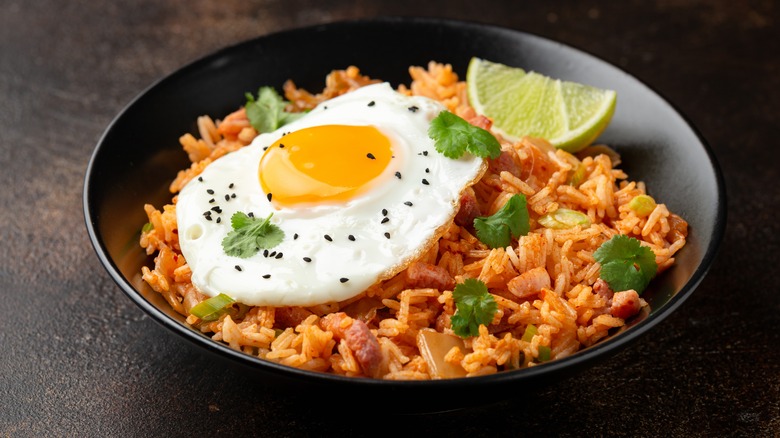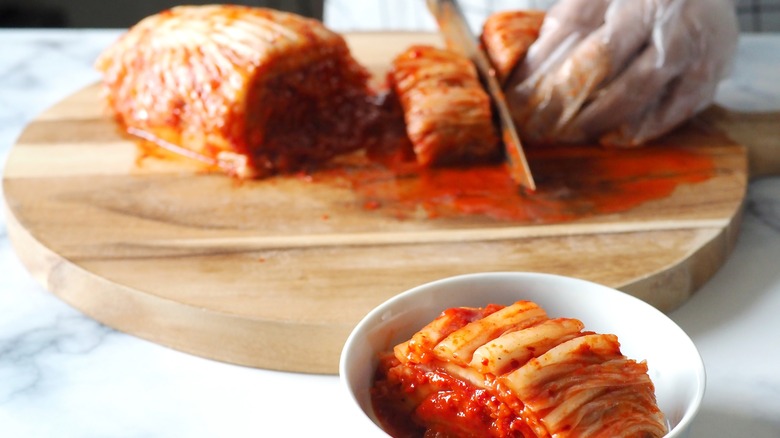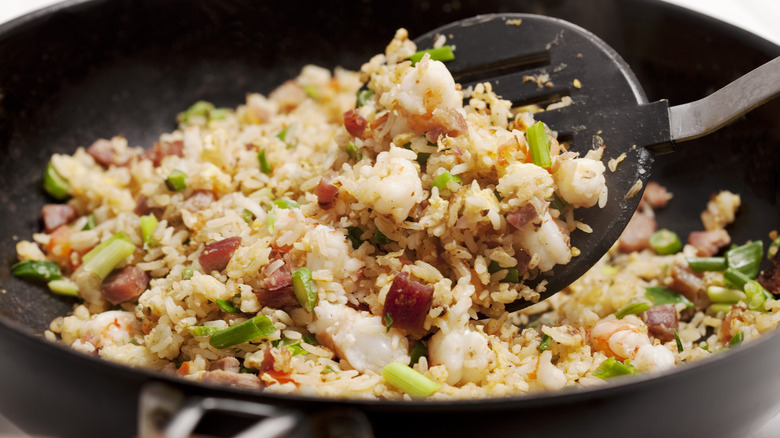The Step You Never Want To Skip When Making Kimchi Fried Rice
Kimchi fried rice is one of the best ways to use kimchi – a satisfying, deeply flavorful, filling meal that comes together with just a few ingredient. Whether homemade or store-bought, the kimchi is the star here in all its funky glory, but another huge chunk of the appeal is the gratifying crunch of the crispy rice. To avoid winding up with a soggy dish, you'll have to give a little TLC to your kimchi first.
To avoid a wet final result, don't skip out on squeezing the juice out of your kimchi. That spicy, tart fermented liquid is what gives kimchi its unmistakable mashup of umami, salty, sweet, and funky flavors. Add the pickles to your fried rice straight out of the jar, though, and the excess of liquid will turn your dish to mush.
This isn't to say you should discard that precious pickling liquid — you'll need it to keep the leftover kimchi in the jar fresh for later, and the juice itself can be used in meat marinades, sauces, dressings, and more. Wring out your kimchi over a bowl, so the excess juice can go back into the container. Once your kimchi is dry, you'll also be able to give it a nice browning in the pan, which is harder to achieve with wet ingredients. Caramelizing the kimchi imparts another layer of sweet, crispy goodness that'll level up your bowl of fried rice.
How to prepare your kimchi for fried rice
Draining kimchi is an easy task. If you want to avoid staining your hands bright red, it's best to grab a pair of rubber or latex gloves before handling the pickles. Grab a kitchen towel or a few paper towels and place the kimchi on top, then twist the ends of the towel closed. Squeeze the towel to wring the liquid out of the kimchi, doing so over a bowl to reserve the liquid. Then, all you have to do is chop the kimchi into bite-size pieces and proceed with your fried rice recipe.
Keep in mind that if you plan to use homemade kimchi, like homemade baechu (Napa cabbage) kimchi, it's best to use it for fried rice after it's had a couple of weeks to ferment. This will ensure that the flavors are at their strongest and ready to enhance your fried rice to its fullest potential. Store-bought kimchi should be ready to use as-is.
Freshly-made homemade kimchi can be enjoyed as a banchan (side dish) or as a topping on other dishes. Waiting a few weeks for it to develop more powerful flavors will be worth the wait for the best fried rice. After all, you don't want the rice itself or other add-ins like meat, veggies, and sauces to water down that delicious kimchi flavor.
Other ways to avoid soggy kimchi fried rice
The other key component of delicious kimchi fried rice is the rice itself. After you've thoroughly dried out your kimchi and caramelized it in a pan, add in the rice. While fresh, moist rice is delicious on its own, it's not the best for fried rice. Just as wet kimchi doesn't brown well, the plentiful moisture in fresh rice can cause it to clump together and resist crisping up in the pan.
Your best bet is to use a batch of rice made a few days earlier. Leftovers have had time to sit and harden up a little bit, losing surface moisture that could inhibit browning. Drier rice also separates into distinct grains more easily, instead of clumping. You'll be able to get some nice, crispy caramelization when the rice is added to the hot pan, giving you sizzling restaurant-quality fried rice.
Toss the kimchi and rice together thoroughly before tamping it down into the surface of the pan. Let it sit so that it forms a crispy crust, resisting the urge to mix it. Give it a final toss, and top the finished rice with a fried egg for some protein, or sliced green onions for a flavorful garnish. Sesame seeds can add a bit of crunch on top, as well. With your kimchi as dry as possible, you'll have a great base to build a world of flavor into your fried rice.


